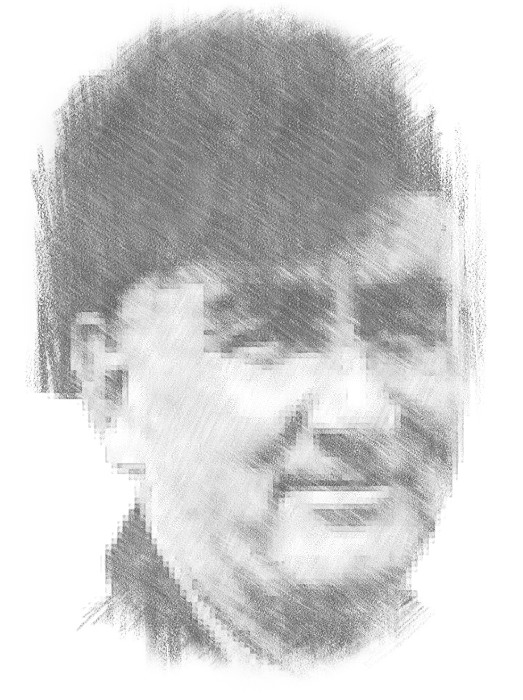
R. Brownell McGrew, CA
(1916-1994)
Aspiring artists used to ask R. Brownell McGrew to show them his tricks. There aren’t any tricks, he would tell them. For McGrew, painting grew out of passion, and patience. McGrew rarely talked about painting; but his stated goal was “to paint as well as I can, in order to communicate the infinite thrill and rapture of God’s creation.”
McGrew was born in Columbus, Ohio, in 1916, and his family moved to California during his middle school years. From 1936 to 1940 he attended the Otis Art Institute in Los Angeles. McGrew acknowledged that, although he had many fine teachers, Ralph Holmes had a “profound and decisive influence” on him. “He taught entirely by principle; by creating a sort of ambient aesthetic,” McGrew wrote. “Never once in my years with him did he demonstrate or teach technique. It’s a slow way to learn, but if one’s patience and money hold out; probably the best.”
McGrew spent the war years designing and drafting material for Firestone. In 1946, he was the first recipient of the John F. and Ann Lee Stacey Fellowship; and he used the money for intensive study of the Western landscape. In the mid-1950’s, he traveled to Arizona with Jimmy Swinnerton, who was known as the Dean of Desert Painters. There, McGrew met Navajo and Hopi people, whose way of life inspired his admiration.
In the late 1960’s, McGrew was invited to become a member of the Cowboy Artists of America, “a singularly generous and broad-minded gesture on the part of the cowboys,” he wrote. In the mid-1970’s, however, he was forced to tender his resignation, because his careful and slow process made it difficult for him to present new work for each annual show. One of the honors of his career, he said, was “having the CAA fellows request me to reconsider my resignation.” McGrew continued as an emeritus member of the CAA, contributing to the shows as time permitted, until his death in 1994.
Source: Cowboy Artists of America

Night Whiskers
Artist: R. Brownell McGrew, CA (1916-1994)
Description: Charcoal (Circa 1970’s) | Image Size: 24”h x 18”w; Framed Size: 34 ¼”h x 28 ¼”wdrawing
A loaned image of R. Brownell McGrew’s “Night Whiskers” was provided to Western Art & Architecture Magazine and appeared in a perspective piece (Dec 2019-January 2020 Edition) written by Steve Winston. In it he wrote “Ralph Brownell McGrew is considered by some to be one of the best Western portraitists of the 20th century. He painted portraits of the Diné (Navajo) and Hopi people of Arizona and New Mexico with such exceptional ability that his work is often said to appear three-dimensional. McGrew became a familiar sight on the reservations. Initially people were somewhat uncomfortable with the idea of someone painting their picture, but as they got to know him, they eventually became comfortable enough to sit for portraits. Over time, McGrew became known among the tribes as “The Man Who Paints the Old.”
Profile of Yellow Hair’s Son
Artist: R. Brownell McGrew, CA (1916-1994)
Description: Charcoal (1973) | Image Size: 24”h x 18”w; Framed Size: 33”h x 28”wdrawing
We’re happy to share another outstanding R. Brownell McGrew charcoal portrait, “Profile of Yellow Hair’s Son”. This particular piece was exhibited at The Gilcrease Museum in Tulsa, Oklahoma, in 1988 at a retrospective exhibition of McGrew’s work.
Early in his career McGrew was primarily known for landscapes, however, after his visits to the reservations, he turned almost entirely to painting the scenes of reservation life and the faces of the many individuals he met on those trips. His charcoal portraits shows how much he cared about the people he met and portrayed them all with great skill, sensitivity and let their personalities shine through the canvas.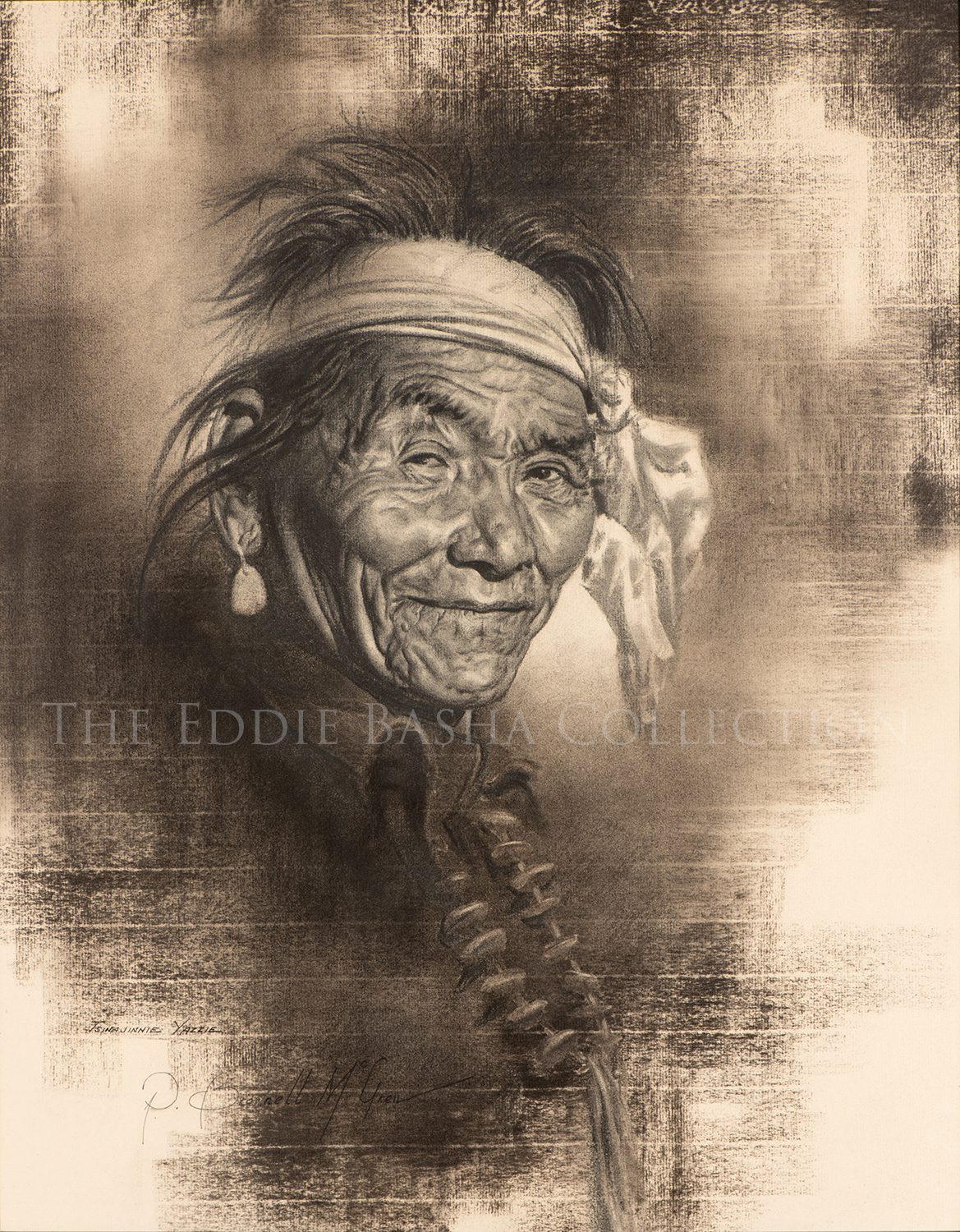
Tsinavinni Yazzi
Artist: R. Brownell McGrew, CA (1916-1994)
Description: Charcoal (1974) | Image Size: 24”h x 18”w; Frame Size: 33”h x 28”wdrawing
R. Brownell McGrew was born in Columbus, Ohio, in 1916, and his family moved to California during his middle school years. From 1936 to 1940 he attended the Otis Art Institute in Los Angeles. McGrew acknowledged that, although he had many fine teachers, Ralph Holmes had a “profound and decisive influence” on him. “He taught entirely by principle; by creating a sort of ambient aesthetic,” McGrew wrote. “Never once in my years with him did he demonstrate or teach technique. It’s a slow way to learn, but if one’s patience and money hold out; probably the best.”
McGrew spent the war years designing and drafting material for Firestone. In 1946, he was the first recipient of the John F. and Ann Lee Stacey Fellowship; and he used the money for intensive study of the Western landscape. In the mid-1950’s, he traveled to Arizona with Jimmy Swinnerton, who was known as the Dean of Desert Painters. There, McGrew met Navajo and Hopi people, whose way of life inspired his admiration and he then focused on painting scenes of reservation life and the many faces of individuals he met on those trips such as Tsinavinni Yazzie. This portrait won the Prix de West Gold Medal Award in Drawing at the 1974 NAWA Sale & Exhibition at the National Cowboy & Western Heritage Museum. It was also more recently featured in the December 2019-January 2020 issue of Western Art & Architecture Magazine in an article entitled “R. Brownell McGrew (1916-1994)” written by Steve Winston.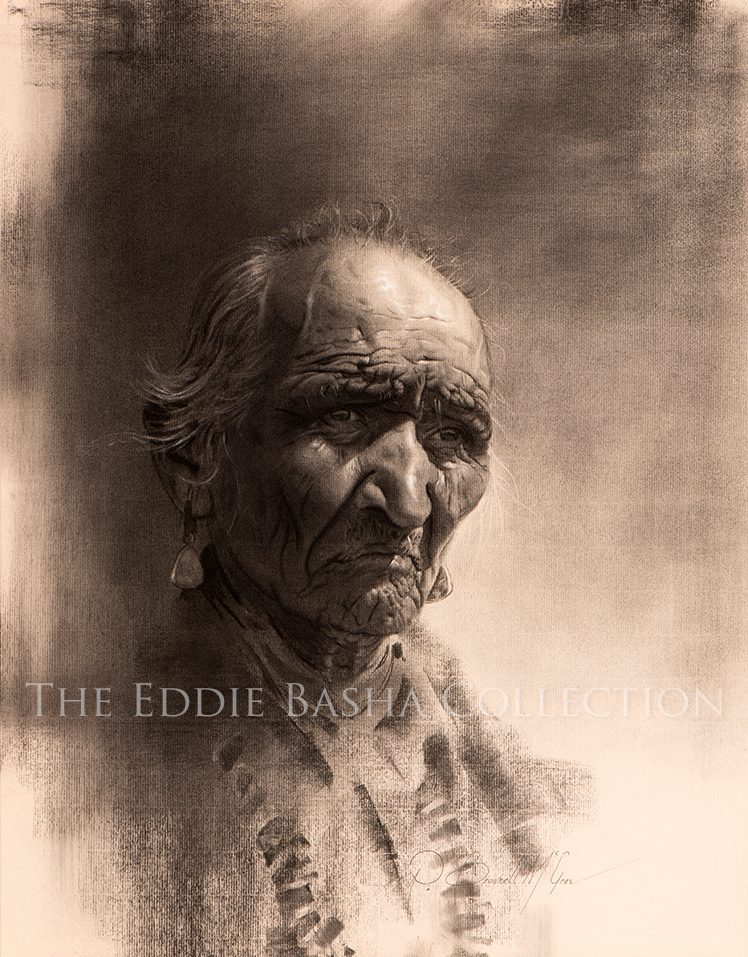
The Old Chieftain
Artist: R. Brownell McGrew, CA (1916-1994)
Description: Charcoal | Image Size: 24”h x 19”wdrawing
McGrew had great respect for the Native People of the American Southwest and a keen eye for their unique features and personalities. He painted and drew their portraits throughout his career. “The Old Chieftan” is typical of many of those portraits. It portrays a unique individual whose history, life experiences and spirit are etched in the lines of his face. The portrait captures the personality of a specific person, but it can also serve as a universal cultural depiction.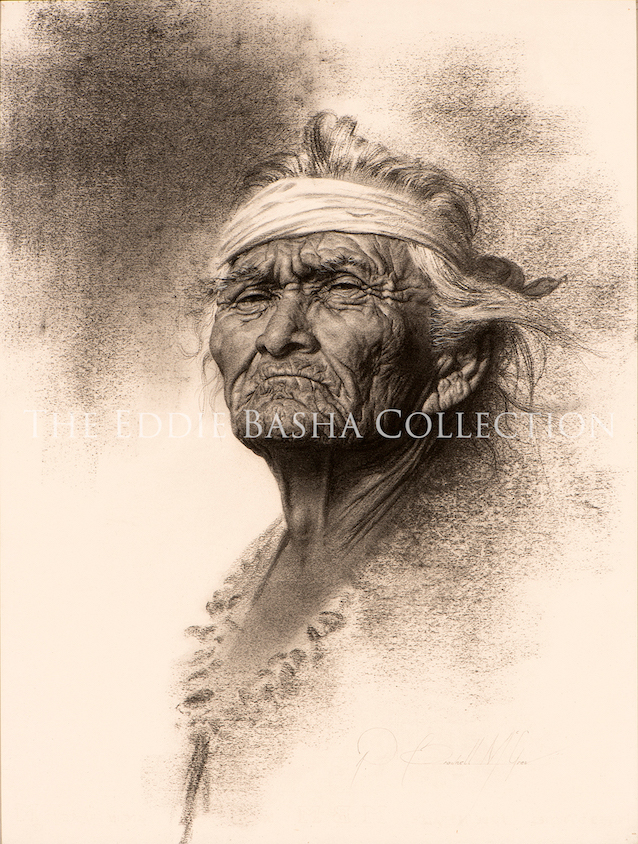
Old John, A Navajo
Artist: R. Brownell McGrew, CA (1916-1994)
Description: Charcoal (1975) | Image Size: 24”h x 18”w; Framed Size: 32 ½”h x 26 ½”wdrawing
R. Brownell McGrew won the Prix de West 1975 Silver Medal Award in drawing for Old John, a Navajo.
Born in Columbus, Ohio, in 1916, R. Brownell McGrew and his family moved to California during his middle school years. From 1936 to 1940, he attended the Otis Art Institute in Los Angeles. McGrew acknowledged that, although he had many fine teachers, Ralph Holmes had a profound and decisive influence on him. After graduating, McGrew taught briefly at the Otis Institute and then went on to work as a commercial artist for MGM and Columbia studios.
During World War II, McGrew served as a designer and draftsman for Firestone. In 1946, he was the first recipient of the John F. and Ann Lee Stacey Fellowship and utilized this award money to immerse himself in the study of the Western landscape. In the mid-1950s, he traveled to Arizona with Jimmy Swinnerton, who was known as the Dean of Desert Painters. There with Swinnerton, McGrew met members of the Navajo and Hopi tribes, whose ancient way of life would serve as the inspiration for his later career.
The Singer
Artist: R. Brownell McGrew, CA (1916-1994)
Description: Charcoal | Image Size: 24”h X 18”w; Framed Size: 32 ½”h x 26 ½”wdrawing
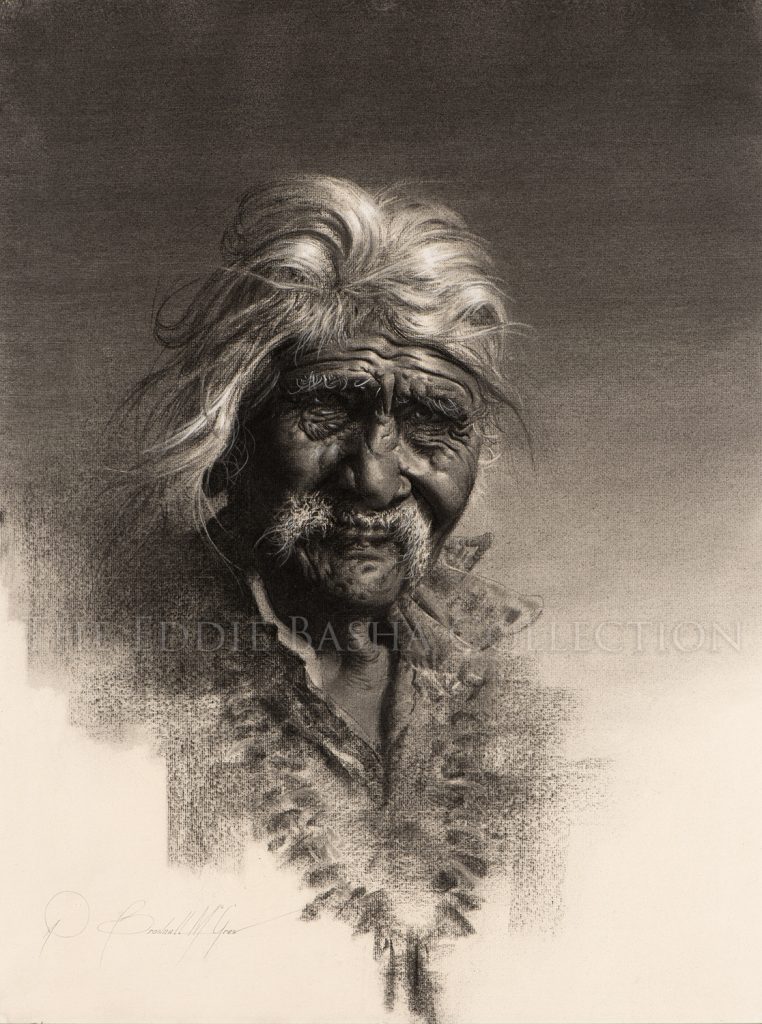 Charcoal (Circa 1970’s) | Image Size: 24”h x 18”w; Framed Size: 34 ¼”h x 28 ¼”w
Charcoal (Circa 1970’s) | Image Size: 24”h x 18”w; Framed Size: 34 ¼”h x 28 ¼”wA loaned image of R. Brownell McGrew’s “Night Whiskers” was provided to Western Art & Architecture Magazine and appeared in a perspective piece (Dec 2019-January 2020 Edition) written by Steve Winston. In it he wrote “Ralph Brownell McGrew is considered by some to be one of the best Western portraitists of the 20th century. He painted portraits of the Diné (Navajo) and Hopi people of Arizona and New Mexico with such exceptional ability that his work is often said to appear three-dimensional. McGrew became a familiar sight on the reservations. Initially people were somewhat uncomfortable with the idea of someone painting their picture, but as they got to know him, they eventually became comfortable enough to sit for portraits. Over time, McGrew became known among the tribes as “The Man Who Paints the Old.”
Night Whiskers
Artist: R. Brownell McGrew, CA (1916-1994)
A loaned image of R. Brownell McGrew’s “Night Whiskers” was provided to Western Art & Architecture Magazine and appeared in a perspective piece (Dec 2019-January 2020 Edition) written by Steve Winston. In it he wrote “Ralph Brownell McGrew is considered by some to be one of the best Western portraitists of the 20th century. He painted portraits of the Diné (Navajo) and Hopi people of Arizona and New Mexico with such exceptional ability that his work is often said to appear three-dimensional. McGrew became a familiar sight on the reservations. Initially people were somewhat uncomfortable with the idea of someone painting their picture, but as they got to know him, they eventually became comfortable enough to sit for portraits. Over time, McGrew became known among the tribes as “The Man Who Paints the Old.”
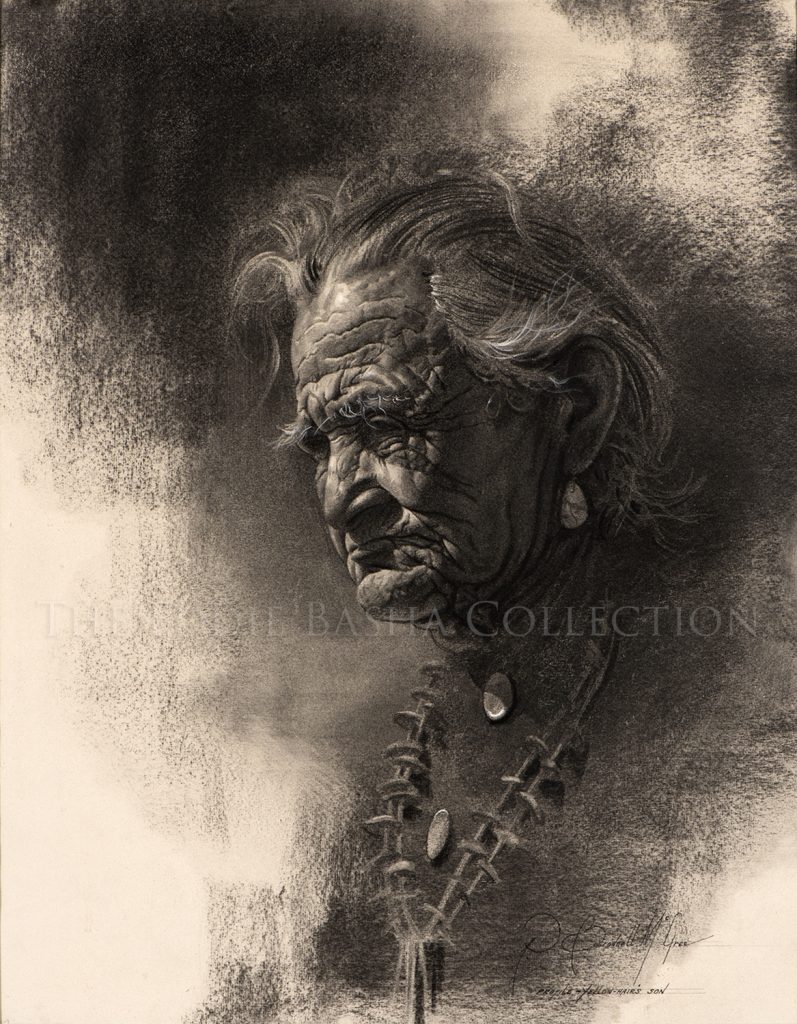 Charcoal (1973) | Image Size: 24”h x 18”w; Framed Size: 33”h x 28”w
Charcoal (1973) | Image Size: 24”h x 18”w; Framed Size: 33”h x 28”wWe’re happy to share another outstanding R. Brownell McGrew charcoal portrait, “Profile of Yellow Hair’s Son”. This particular piece was exhibited at The Gilcrease Museum in Tulsa, Oklahoma, in 1988 at a retrospective exhibition of McGrew’s work.
Early in his career McGrew was primarily known for landscapes, however, after his visits to the reservations, he turned almost entirely to painting the scenes of reservation life and the faces of the many individuals he met on those trips. His charcoal portraits shows how much he cared about the people he met and portrayed them all with great skill, sensitivity and let their personalities shine through the canvas.
Profile of Yellow Hair’s Son
Artist: R. Brownell McGrew, CA (1916-1994)
We’re happy to share another outstanding R. Brownell McGrew charcoal portrait, “Profile of Yellow Hair’s Son”. This particular piece was exhibited at The Gilcrease Museum in Tulsa, Oklahoma, in 1988 at a retrospective exhibition of McGrew’s work.
Early in his career McGrew was primarily known for landscapes, however, after his visits to the reservations, he turned almost entirely to painting the scenes of reservation life and the faces of the many individuals he met on those trips. His charcoal portraits shows how much he cared about the people he met and portrayed them all with great skill, sensitivity and let their personalities shine through the canvas.
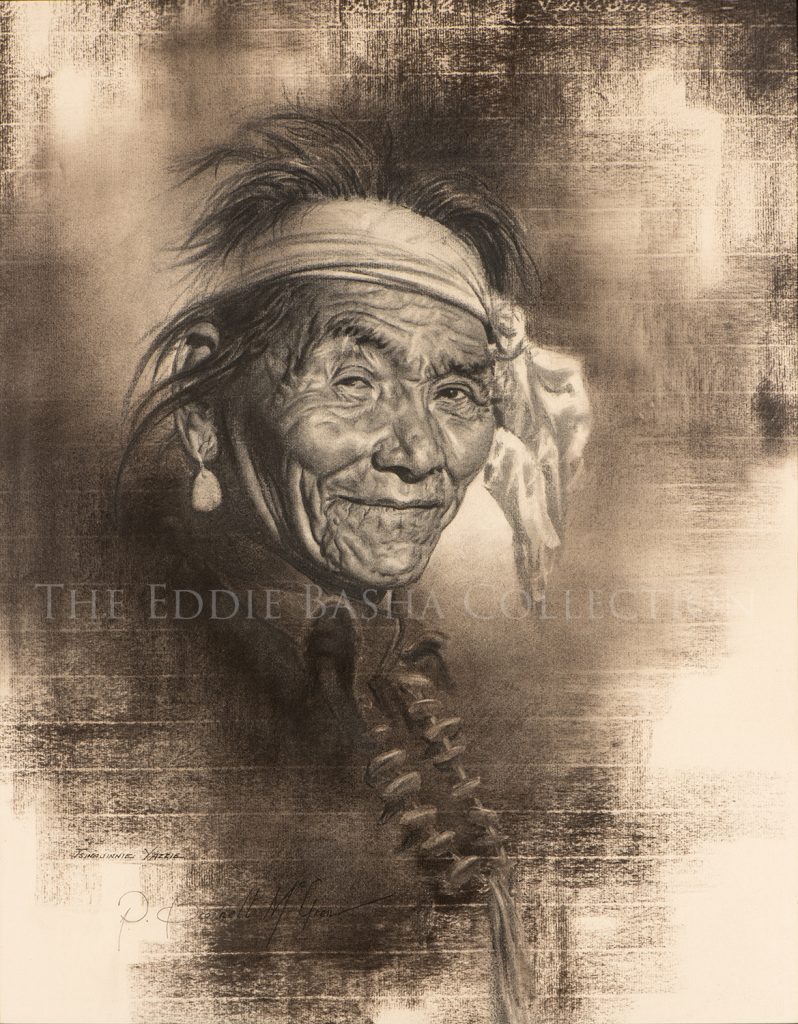 Charcoal (1974) | Image Size: 24”h x 18”w; Frame Size: 33”h x 28”w
Charcoal (1974) | Image Size: 24”h x 18”w; Frame Size: 33”h x 28”wR. Brownell McGrew was born in Columbus, Ohio, in 1916, and his family moved to California during his middle school years. From 1936 to 1940 he attended the Otis Art Institute in Los Angeles. McGrew acknowledged that, although he had many fine teachers, Ralph Holmes had a “profound and decisive influence” on him. “He taught entirely by principle; by creating a sort of ambient aesthetic,” McGrew wrote. “Never once in my years with him did he demonstrate or teach technique. It’s a slow way to learn, but if one’s patience and money hold out; probably the best.”
McGrew spent the war years designing and drafting material for Firestone. In 1946, he was the first recipient of the John F. and Ann Lee Stacey Fellowship; and he used the money for intensive study of the Western landscape. In the mid-1950’s, he traveled to Arizona with Jimmy Swinnerton, who was known as the Dean of Desert Painters. There, McGrew met Navajo and Hopi people, whose way of life inspired his admiration and he then focused on painting scenes of reservation life and the many faces of individuals he met on those trips such as Tsinavinni Yazzie. This portrait won the Prix de West Gold Medal Award in Drawing at the 1974 NAWA Sale & Exhibition at the National Cowboy & Western Heritage Museum. It was also more recently featured in the December 2019-January 2020 issue of Western Art & Architecture Magazine in an article entitled “R. Brownell McGrew (1916-1994)” written by Steve Winston.
Tsinavinni Yazzi
Artist: R. Brownell McGrew, CA (1916-1994)
R. Brownell McGrew was born in Columbus, Ohio, in 1916, and his family moved to California during his middle school years. From 1936 to 1940 he attended the Otis Art Institute in Los Angeles. McGrew acknowledged that, although he had many fine teachers, Ralph Holmes had a “profound and decisive influence” on him. “He taught entirely by principle; by creating a sort of ambient aesthetic,” McGrew wrote. “Never once in my years with him did he demonstrate or teach technique. It’s a slow way to learn, but if one’s patience and money hold out; probably the best.”
McGrew spent the war years designing and drafting material for Firestone. In 1946, he was the first recipient of the John F. and Ann Lee Stacey Fellowship; and he used the money for intensive study of the Western landscape. In the mid-1950’s, he traveled to Arizona with Jimmy Swinnerton, who was known as the Dean of Desert Painters. There, McGrew met Navajo and Hopi people, whose way of life inspired his admiration and he then focused on painting scenes of reservation life and the many faces of individuals he met on those trips such as Tsinavinni Yazzie. This portrait won the Prix de West Gold Medal Award in Drawing at the 1974 NAWA Sale & Exhibition at the National Cowboy & Western Heritage Museum. It was also more recently featured in the December 2019-January 2020 issue of Western Art & Architecture Magazine in an article entitled “R. Brownell McGrew (1916-1994)” written by Steve Winston.
 Charcoal | Image Size: 24”h x 19”w
Charcoal | Image Size: 24”h x 19”wMcGrew had great respect for the Native People of the American Southwest and a keen eye for their unique features and personalities. He painted and drew their portraits throughout his career. “The Old Chieftan” is typical of many of those portraits. It portrays a unique individual whose history, life experiences and spirit are etched in the lines of his face. The portrait captures the personality of a specific person, but it can also serve as a universal cultural depiction.
The Old Chieftain
Artist: R. Brownell McGrew, CA (1916-1994)
McGrew had great respect for the Native People of the American Southwest and a keen eye for their unique features and personalities. He painted and drew their portraits throughout his career. “The Old Chieftan” is typical of many of those portraits. It portrays a unique individual whose history, life experiences and spirit are etched in the lines of his face. The portrait captures the personality of a specific person, but it can also serve as a universal cultural depiction.
 Charcoal (1975) | Image Size: 24”h x 18”w; Framed Size: 32 ½”h x 26 ½”w
Charcoal (1975) | Image Size: 24”h x 18”w; Framed Size: 32 ½”h x 26 ½”wR. Brownell McGrew won the Prix de West 1975 Silver Medal Award in drawing for Old John, a Navajo.
Born in Columbus, Ohio, in 1916, R. Brownell McGrew and his family moved to California during his middle school years. From 1936 to 1940, he attended the Otis Art Institute in Los Angeles. McGrew acknowledged that, although he had many fine teachers, Ralph Holmes had a profound and decisive influence on him. After graduating, McGrew taught briefly at the Otis Institute and then went on to work as a commercial artist for MGM and Columbia studios.
During World War II, McGrew served as a designer and draftsman for Firestone. In 1946, he was the first recipient of the John F. and Ann Lee Stacey Fellowship and utilized this award money to immerse himself in the study of the Western landscape. In the mid-1950s, he traveled to Arizona with Jimmy Swinnerton, who was known as the Dean of Desert Painters. There with Swinnerton, McGrew met members of the Navajo and Hopi tribes, whose ancient way of life would serve as the inspiration for his later career.
Old John, A Navajo
Artist: R. Brownell McGrew, CA (1916-1994)
R. Brownell McGrew won the Prix de West 1975 Silver Medal Award in drawing for Old John, a Navajo.
Born in Columbus, Ohio, in 1916, R. Brownell McGrew and his family moved to California during his middle school years. From 1936 to 1940, he attended the Otis Art Institute in Los Angeles. McGrew acknowledged that, although he had many fine teachers, Ralph Holmes had a profound and decisive influence on him. After graduating, McGrew taught briefly at the Otis Institute and then went on to work as a commercial artist for MGM and Columbia studios.
During World War II, McGrew served as a designer and draftsman for Firestone. In 1946, he was the first recipient of the John F. and Ann Lee Stacey Fellowship and utilized this award money to immerse himself in the study of the Western landscape. In the mid-1950s, he traveled to Arizona with Jimmy Swinnerton, who was known as the Dean of Desert Painters. There with Swinnerton, McGrew met members of the Navajo and Hopi tribes, whose ancient way of life would serve as the inspiration for his later career.